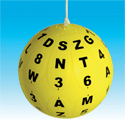Vision Therapy Tools, Part 2
 I introduced you in September to some simple yet effective tools used in our Vision Therapy clinic. In this follow-up, I will cover some other common tools and equipment used in Vision Therapy, and in a future post I will discuss in depth some of the sophisticated computerized hardware and software we use.
I introduced you in September to some simple yet effective tools used in our Vision Therapy clinic. In this follow-up, I will cover some other common tools and equipment used in Vision Therapy, and in a future post I will discuss in depth some of the sophisticated computerized hardware and software we use.
Much of what we do in clinic looks like fun and games. An observer may wonder how a trampoline and low balance beam can be visually therapeutic. Much of our functionality in life depends on the eyes, brain and body working cooperatively. Depending on the visual problem, we may use the apparatuses in conjunction with prismatic glasses or an eye patch. Patients perform exercises like reading a wall chart while balancing or bouncing, or playing catch with bean bags. This helps improve spatial awareness and coordination.
Patients also use mazes, pickup sticks and pegboard games that are specially designed to disrupt suppression, which happens when the brain ignores the images from one eye.
Marsden balls are baseball-size spheres covered in letters and numbers, and typically suspended from the ceiling. We use these in a variety of ways. For example, as the ball swings around, a patient calls out the letters or numbers. Over time, this improves eye tracking and accommodation skills as well as body awareness. Accommodation is the ability of the eyes to change focus back and forth between near objects and far objects. Athletes also use Marsden balls in training to quicken their responses.
Flippers are two pairs of lenses that patients “flip” while reading, changing the demands on their eyes in order to “fine-tune” muscle movements and coordination. In doing so, patients improve accommodation and focusing, which are necessary to follow along in the classroom and to keep words clear on a page while reading.
Our young patients have fun in vision therapy; however, it does require a commitment and homework, and some therapies are frustrating at first. Patients who stick with it say the payoff is well worth the time and effort and lasts for a lifetime.
Dr. Jeff Pinkerton
I care for you.
Comments are closed.

I can honestly say that the vision therapy works. My child who could not read very well in 2nd grade, went through vision therapy. There were alot of tears and i dont want tos. But we stuck with it. My daughter who is now in 8th grade is going to UIL for reading aloud. Wow. I never thought this would happen. There was a ton of hard work to get her to this point. Now she loves reading and even reads her bible every night before she goes to bed. She is my inspiration.
Thank you Dr. Pinkerton for the hard work from you and your staff.
Your daughter was one of our stars! So glad her hard work is paying off.